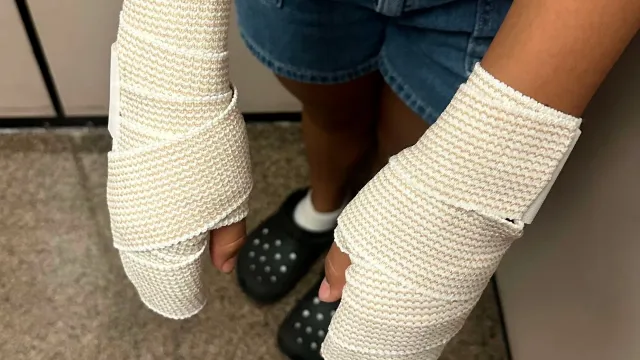Ever noticed that doctors’ surgical gowns are almost always blue (or sometimes green)? You might wonder, why not red, purple, or any other color? The answer isn’t random—it’s rooted in science, psychology, and the visual demands of an operating room. Let’s explore why blue is the go-to color for surgical attire and how it helps medical professionals perform at their best.
The Science of Color Perception in the Operating Room

Operating rooms are high-intensity environments where doctors spend hours focused on intricate surgical tasks. The choice of color in the operating room, particularly for surgical gowns, is designed to reduce visual strain and enhance clarity. But why blue?
During surgery, doctors are constantly exposed to shades of red from blood and tissue. When you stare at one color for an extended time, you can experience an “afterimage”—a visual impression that stays in your vision when you look away. For surgeons, this can create a distraction. Here’s where blue (or green) comes in: as opposite colors to red on the color wheel, blue and green counteract these afterimages, making them a scientifically sound choice for operating rooms.
1. How Blue Helps Combat Visual Fatigue
Surgery often requires doctors to focus on their work for extended periods under bright lights, and eye strain is a real concern. Blue gowns help counteract this in a few ways:
Reduces Eye Strain
When exposed to a single color, like red, for long periods, your eyes can become fatigued. Blue helps neutralize the afterimages caused by red hues, enabling surgeons to see clearly without added distraction.
Balances Eye Sensitivity
The constant exposure to red can reduce sensitivity to it over time. Blue tones help “reset” the eyes, easing strain and preventing overstimulation, which is particularly beneficial when doctors shift their gaze from red tissue to their blue scrubs.
Improves Depth Perception
Blue and green colors provide a high level of contrast to red, which enhances depth perception and detail recognition—both essential for delicate surgical tasks. This contrast allows doctors to discern subtle shades and tissue depth more effectively.
2. Psychological Benefits of Blue and Green in the Operating Room
The color blue is often associated with calmness, focus, and tranquility—qualities that are highly beneficial in a stressful environment like an operating room. Here’s how the psychology of color comes into play:
Promotes a Calming Atmosphere
Blue tones create a serene environment, which can reduce stress for the entire surgical team. Less stress allows surgeons to focus more clearly on their tasks and make calm, rational decisions during critical moments.

Enhances Focus and Reduces Distractions
In an operating room, bright colors like red or yellow could easily become a distraction. Blue, on the other hand, is a subdued tone that helps maintain focus on the patient without unnecessary visual clutter. The consistent backdrop of blue scrubs keeps the surgical team concentrated on the procedure.
3. Why Not Choose Other Colors Like Red, Purple, or Yellow?
With blue and green providing such strong benefits, it’s worth considering why other colors don’t make the cut.
Red: Overwhelming and Confusing
A red gown would blend with the color of blood and tissue, making it difficult to distinguish between the doctor’s attire and the patient. Red is also an intense color that can raise heart rates, potentially adding an extra layer of stress to an already demanding environment.
Purple: Distracting and Ineffective
While purple may be calming in some settings, it doesn’t provide the same level of contrast against red tones as blue or green. Purple’s red undertones can also lead to eye strain rather than alleviating it, making it less effective in an operating room setting.
Yellow: Bright and Reflective
Yellow’s high brightness could create unnecessary reflections under the strong surgical lights, causing eye strain. Additionally, yellow doesn’t offer the same counterbalancing effect against red hues, making it unsuitable for minimizing visual fatigue during surgery.
4. The Role of Color Theory in Choosing Blue and Green

Color theory explains that complementary colors (those opposite each other on the color wheel) create visual harmony. In this case, blue and green contrast with red, neutralizing the intense visual stimuli from blood and tissue. By using these complementary colors, hospitals can help surgeons avoid overstimulation, enabling them to work with greater precision and focus.
How Complementary Colors Help Surgeons
Using blue or green “resets” the retina by stimulating different cones in the eye, balancing out the constant red exposure and helping the brain process what it sees more accurately. This visual balance is why hospitals overwhelmingly prefer blue or green surgical attire over other colors.
5. Green Surgical Gowns: An Alternative with Similar Benefits
Though blue is the most common choice, green is sometimes used as an alternative. Both colors sit opposite red on the color wheel, offering similar benefits for counteracting afterimages and reducing eye strain. Hospitals may choose green to match the aesthetic of their operating room equipment or simply for a different look, but the benefits of green are largely the same as those of blue.
How Hospitals Benefit from Blue and Green Gowns
Beyond aiding individual surgeons, blue and green uniforms have a range of additional benefits for hospitals:
- Enhanced Safety: Improved visual clarity contributes to a safer operating environment, reducing the risk of surgical errors.
- Reduced Eye Fatigue for Staff: With multiple surgeries taking place throughout the day, hospital staff can experience less visual fatigue, which supports better overall performance.
- Improved Patient Outcomes: By helping doctors maintain a high level of focus, blue and green attire indirectly supports better surgical outcomes and patient safety.
Conclusion: The Power of Blue in the Operating Room
While it may seem like a simple choice, the color of surgical gowns plays a critical role in the functionality and success of an operating room. Blue—and sometimes green—gowns reduce eye strain, promote calmness, and enhance visual clarity, enabling surgeons to perform at their best. These colors’ soothing properties and scientifically-backed visual benefits are a testament to the thought and care that goes into even the smallest details of surgical environments.
Next time you see a doctor in a blue gown, remember that it’s more than just a uniform—it’s a tool that helps them maintain focus and achieve success in some of the most challenging moments.


